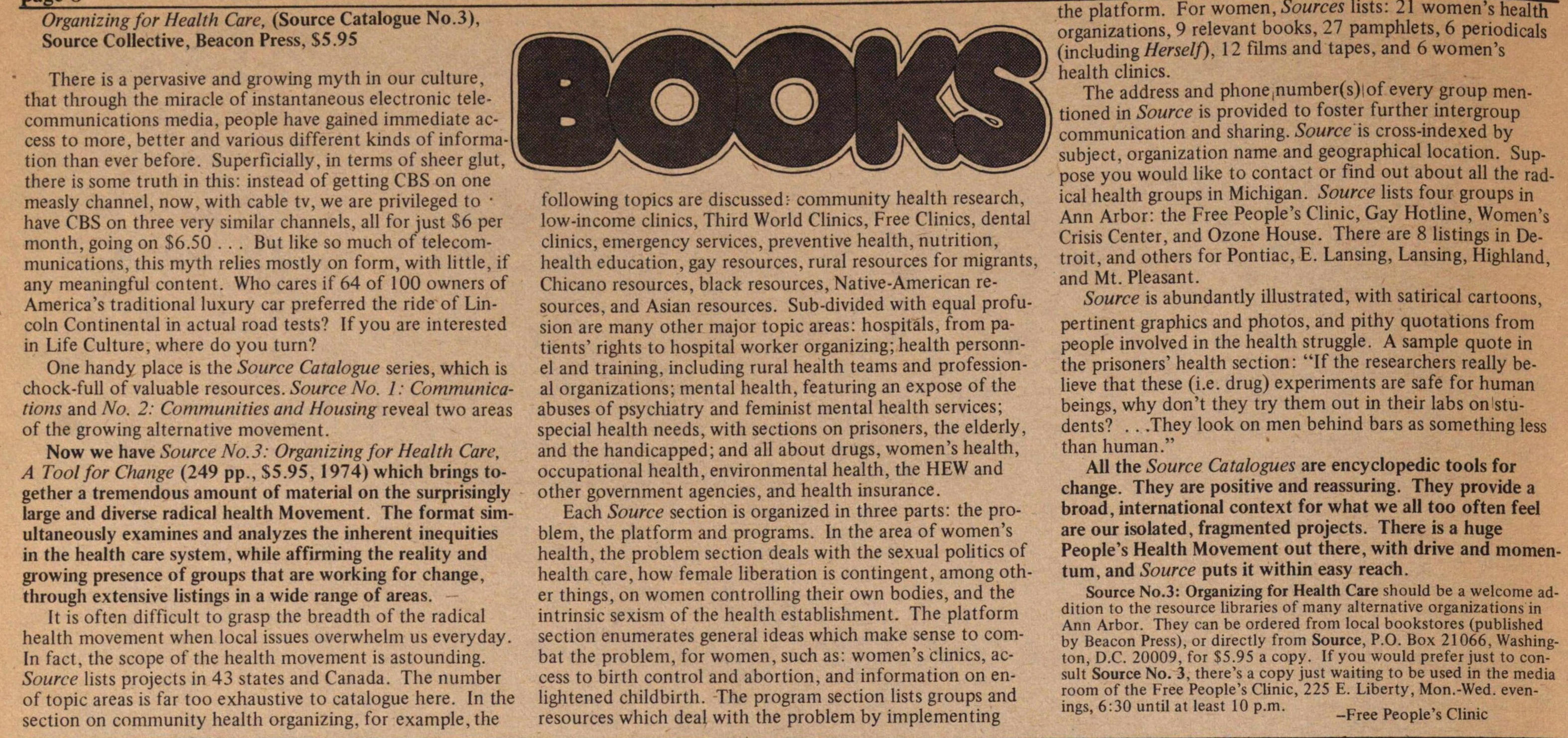Books

Organizing for Health Care, (Source Catalogue No.3), Source Collective, Beacon Press, $5.95
There is a pervasive and growing myth in our culture, that through the miracle of instantaneous electronic telecommunications media, people have gained immediate access to more, better and various different kinds of information than ever before. Superficially, in terms of sheer glut, there is some truth in this: instead of getting CBS on one measly channel, now, with cable tv, we are privileged to have CBS on three very similar channels, all for just $6 per month, going on $6.50 . . . But like so much of telecommunications, this myth relies mostly on form, with little, if any meaningful content. Who cares if 64 of 100 owners of America 's traditional luxury car preferred the ride of Lincoln Continental in actual road tests? If you are interested in Life Culture, where do you turn?
One handy place is the Source Catalogue series, which is chock-full of valuable resources. Source No. 1: Communications and No. 2: Communities and Housing reveal two areas of the growing alternative movement.
Now we have Source No.3: Organizing for Health Care, A Tool for Change (249 pp., $5.95, 1974) which brings together a tremendous amount of material on the surprisingly large and diverse radical health Movement. The format simultaneously examines and analyzes the inherent inequities in the health care system, while affirming the reality and growing presence of groups that are working for chan8ge, through extensive listings in a wide range of areas.
It is often difficult to grasp the breadth of the radical health movement when local issues overwhelm us everyday. In fact, the scope of the health movement is astounding. Source lists projects in 43 states and Canada. The number of topic areas is far too exhaustive to catalogue here. In the section on community health organizing, for example, the following topics are discussed; community health research, low-income clinics, Third World Clinics, Free Clinics, dental clinics, emergency services, preventive health, nutrition, health education, gay resources, rural resources for migrants, Chicano resources, black resources, Native-American resources, and Asian resources. Sub-divided with equal profusion are many other major topic areas: hospitals, from patients' rights to hospital worker organizing; health personnel and training, including rural health teams and professional organizations; mental health, featuring an expose of the abuses of psychiatry and feminist mental health services; special health needs, with sections on prisoners, the elderly, and the handicapped; and all about drugs, women's health, occupational health, environmental health, the HEW and other government agencies, and health insurance.
Each Source section is organized in three parts: the problem, the platform and programs. In the area of women's health, the problem section deals with the sexual politics of health care, how female liberation is contingent, among other things, on women controlling their own bodies, and the intrinsic sexism of the health establishment. The platform section enumerates general ideas which make sense to combat the problem, for women, such as: women's clinics, access to birth control and abortion, and information on enlightened childbirth. The program section lists groups and resources which deal with the problem by implementing the platform. For women, Sources Iists: 21 women's health organizations, 9 relevant books, 27 pamphlets, 6 periodicals (including herself), 12 films and tapes, and 6 women's health clinics.
The address and phone number(s) of every group mentioned in Source is provided to foster further intergroup ' communication and sharing. Source is cross-indexed by subject, organization name and geographical location. Suppose you would like to contact or find out about all the radical health groups in Michigan. Source Iists four groups in Ann Arbor: the Free People's Clinic, Gay Hotline, Women's Crisis Center, and Ozone House. There are 8 listings in Detroit, and others for Pontiac, E. Lansing, Lansing, Highland, and Mt. Pleasant.
Source is abundantly illustrated, with satirical cartoons, pertinent graphics and photos, and pithy quotations from people involved in the health struggle. A sample quote in the prisoners' health section: "If the researchers really believe that these (i.e. drug) experiments are safe for human beings, why don't they try them out in their labs on students? . . .They look on men behind bars as something less than human."
All the Source Catalogues are encyclopedic tools for change. They are positive and reassuring. They provide a broad, international context for what we all too often feel are our isolated, fragmented projects. There is a huge People's Health Movement out there, with drive and momentum, and Source puts it within easy reach.
Source No.3: Organizing for Health Care should be a welcome addition to the resource libraries of many alternative organizations in Ann Arbor. They can be ordered from local bookstores (published by Beacon Press), or directly from Source, P.O. Box 21066, Washington, D.C. 20009, for $5.95 a copy. If you would prefer just to consult Source No. 3, there's a copy just waiting to be used in the media room of the Free People's Clinic, 225 E. Liberty, Mon.-Wed. evenings, 6:30 until at least 10 p.m.
--Free People’s Clinic
Article
Subjects
Freeing John Sinclair
Old News
Ann Arbor Sun